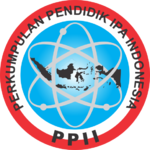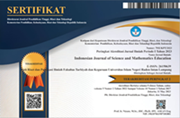How do Indonesian students respond to ethnomathematics-based learning in the digital era?
Abstract
Keywords
Full Text:
PDFReferences
C. E. Allen, M. E. Froustet, J. F. LeBlanc, J. N. Payne, A Priest, J. F. Reed, J. E. Worth, G. M. Thomason, B. Robinson, and J. N. Payne, “National council of teachers of mathematics,” Arith. Teach., vol. 29, no. 5, pp. 59-59, 1982, doi: 10.5951/AT.29.5.0059
R. Nirawati, S. Fatimah, and D. Juandi, “Realistic mathematics learning on students’ ways of thinking.,” Math. Teach. Res. J., vol. 13, no. 4, pp. 112–130, 2021.
I. Rachmawati, “Eksplorasi etnomatematika masyarakat Sidoarjo,” MATHEdunesa, vol. 1, no. 1, 2012.
C. A. Rodríguez-Nieto and Á. Alsina, “Networking between ethnomathematics, STEAM education, and the globalized approach to analyze mathematical connections in daily practices,” Eurasia J. Math. Sci. Technol. Educ. 2022, vol. 18, no. 3, pp. 1-22, 2022, doi: 10.29333/ejmste/11710
A. Brandt and E. J. Chernoff, “The importance of ethnomathematics in the math class,” Ohio J. Sch. Math., vol. 71, no. 71, pp. 31–37, 2015.
J. B. Darmayasa, W. Wahyudin, and T. Mulyana, “Ethnomathematics: Operasi bilangan bulat pada aturan †œpetemuan†masyarakat Bali,” Math. Educ. Appl. J., vol. 1, no. 1, pp. 1–7, 2019, doi: 10.35334/meta.v1i1.834
E. M. Awaliyah, “Peran etnomatematika di sekolah dalam upaya peningkatan stigma positif pelajar terhadap pembelajaran matematika,” J. Didact. Math., vol. 2, no. 1, pp. 23–30, 2019, doi: 10.31949/dmj.v2i1.1668
R. C. I. Prahmana and U. D’Ambrosio, “Learning geometry and values from patterns: ethnomathematics on the batik patterns of Yogyakarta, Indonesia,” J. Math. Educ., vol. 11, no. 3, pp. 439–456, 2020, doi: 10.22342/jme.11.3.12949.439-456
Setiyani, D. P. Putri, F. Ferdianto, and S. H. Fauji, “Designing a digital teaching module based on mathematical communication in relation and function,” J. Math. Educ., vol. 11, no. 2, pp. 223–236, 2020, doi: 10.22342/jme.11.2.7320.223-236
D. A. Kusuma, D. Suryadi, and J. A. Dahlan, “Improving external mathematical connections and students’ activity using ethnomathematics,” in Journal of Physics: Conference Series, 2019, vol. 1157, no. 3, p. 32120, doi: 10.1088/1742-6596/1157/3/032120
C. Kivunja, “Innovative pedagogies in higher education to become effective teachers of 21st century skills: Unpacking the learning and innovations skills domain of the new learning paradigm.,” Int. J. High. Educ., vol. 3, no. 4, pp. 37–48, 2014, doi: 10.5430/ijhe.v3n4p37
E. Wulantina, “Respon siswa terhadap bahan ajar matematika berbasis lampungnese etnomatematics,” Triple S (Journals Math. Educ.), vol. 2, no. 2, pp. 45–54, 2022.
S. D. Simanjuntak and I. Imelda, “Respon siswa terhadap pembelajaran matematika realistik dengan konteks budaya Batak Toba,” MES J. Math. Educ. Sci., vol. 4, no. 1, pp. 81–88, 2018, doi: 10.30743/mes.v4i1.874
L. A. Maharani and S. B. Waluya, “Systematic literature review: Implementation of a problem-based learning model with ethnomathematics nuances in improving students’ mathematical problem solving ability,” J. Pendidik. Mat., vol. 1, no. 2, pp. 13-13, 2024, doi: 10.47134/ppm.v1i2.218
I. T. Kusumawati, J. Soebagyo, and I. Nuriadin, “Studi kepustakaan kemampuan berpikir kritis dengan penerapan model PBL pada pendekatan teori konstruktivisme,” J. MathEdu (Mathematic Educ. Journal), vol. 5, no. 1, pp. 13–18, 2022.
A. S. Nur, K. Kartono, Z. Zaenuri, S. B. Waluya, and R. Rochmad, “Ethnomathematics thought and its influence in mathematical learning,” MaPan J. Mat. dan Pembelajaran, vol. 8, no. 2, pp. 205–223, 2020, doi: 10.24252/mapan.2020v8n2a3
A. Imswatama and H. S. Lukman, “The effectiveness of mathematics teaching material based on ethnomathematics,” Int. J. Trends Math. Educ. Res., vol. 1, no. 1, pp. 35–38, 2018, doi: 10.33122/ijtmer.v1i1.11.
H. Pathuddin, Kamariah, and M. Ichsan Nawawi, “Buginese ethnomathematics: Barongko cake explorations as mathematics learning resources,” J. Math. Educ., vol. 12, no. 2, pp. 295–312, 2021, doi: 10.22342/jme.12.2.12695.295-312.
W. Widada, D. Herawaty, and A. Lubis, “Realistic mathematics learning based on the ethnomathematics in Bengkulu to improve students’ cognitive level,” in Journal of Physics: Conference Series, vol. 1088, no. 1, 2018 pp. 1-9, doi: 10.1088/1742-6596/1088/1/012028
A. Lubis, W. Widada, D. Herawaty, K. U. Z. Nugroho, and A. F. D. Anggoro, “The ability to solve mathematical problems through realistic mathematics learning based on ethnomathematics,” in Journal of Physics: Conference Series, vol. 1731, no. 1, 2021, pp. 1-7, doi: 10.1088/1742-6596/1731/1/012050
V. A. Lambert and C. E. Lambert, “Qualitative descriptive research: An acceptable design,” Pacific Rim Int. J. Nurs. Res., vol. 16, no. 4, pp. 255–256, 2012.
A. Habibi et al., “Investigating EFL classroom management in pesantren: A case study,” Qual. Rep., vol. 23, no. 9, pp. 2105–2122, 2018, doi: 10.46743/2160-3715/2018.3117
O. A. Cimen, “Discussing ethnomathematics: Is mathematics culturally dependent?,” Procedia - Soc. Behav. Sci., vol. 152, no. 1, pp. 523–528, 2014, doi: 10.1016/j.sbspro.2014.09.215
A. Q. Fouze and M. Amit, “The importance of ethnomathematics education,” Creat. Educ., vol. 14, no. 4, pp. 729–740, 2023, doi: 10.4236/ce.2023.144048
A. Irawan, G. Kencanawaty, and C. Febriyanti, “Realistic mathematics and ethnomathematics in improving problem solving abilities,” in Journal of Physics: Conference Series, 2018, vol. 1114, no. 1, pp. 1-5, doi: 10.1088/1742-6596/1114/1/012108
M. Masruroh and M. F. Amir, “Innovative learning media: Ethnomathematics-based modules for third-grade of elementary school students,” J. Lesson Learn. Stud., vol. 7, no. 1, pp. 81-93, 2024, doi: 10.23887/jlls.v7i1.68306
D. S. Setiana, “The role of ethnomathematics in welcoming the society 5.0,” in SEMANTIK Conference of Mathematics Education (SEMANTIK 2019), 2020, pp. 130–134, doi: 10.2991/assehr.k.200827.130
M. Rosa and D. Orey, “Ethnomathematics: The cultural aspects of mathematics,” Rev. Latinoam. Etnomatemática Perspect. Sociocult. La Educ. Matemática, vol. 4, no. 2, pp. 32–54, 2011.
M. A. Simon, “Reconstructing mathematics pedagogy from a constructivist perspective,” J. Res. Math. Educ., vol. 26, no. 2, pp. 114–145, 1995, doi: 10.5951/jresematheduc.26.2.0114
S. Dündar and N. Gündüz, “Justification for the subject of congruence and similarity in the context of daily life and conceptual knowledge.,” J. Math. Educ., vol. 8, no. 1, pp. 35–54, 2017, doi: 10.22342/jme.8.1.3256.35-54
I. Payadnya, I. K. Suwija, and K. A. Wibawa, “Analysis of students’ abilities in solving realistic mathematics problems using "what-if"-ethnomathematics instruments.,” Math. Teach. Res. J., vol. 13, no. 4, pp. 131–149, 2021.
P. E. P. Cahirati, A. P. Makur, and S. Fedi, “Analisis kesulitan belajar siswa dalam pembelajaran matematika yang menggunakan pendekatan PMRI,” Mosharafa J. Pendidik. Mat., vol. 9, no. 2, pp. 227–238, 2020, doi: 10.31980/mosharafa.v9i2.576
S. Mania and S. Alam, “Teachers’ perception toward the use of ethnomathematics approach in teaching math,” Int. J. Educ. Math. Sci. Technol., vol. 9, no. 2, pp. 282–298, 2021, doi: 10.46328/ijemst.1551
K. P. Acharya, C. B. Budhathoki, and M. Acharya, “Science learning from the school garden through participatory action research in nepal.,” Qual. Rep., vol. 27, no. 6, pp. 1623-1634, 2022, doi: 10.46743/2160-3715/2022.4561
R. C. I. Prahmana, “Ethno realistic mathematics education: The promising learning approach in the city of culture,” SN Soc. Sci., vol. 2, no. 12, pp. 1–19, 2022, doi: 10.1007/s43545-022-00571-w
S. B. Adjei, “Conceptualizing discursive analysis as a culturally contextualized activity,” Qual. Rep., vol. 24, no. 9, pp. 2233–2243, 2019, doi: 10.46743/2160-3715/2019.4020
Y. Ben-David Kolikant, Discussion: Creating a new world - teachers’ work in innovative educational environments. 2020. doi: 10.1007/978-3-030-29396-3_17.
DOI: http://dx.doi.org/10.24042/ijsme.v7i3.21548
Refbacks
- There are currently no refbacks.
Copyright (c) 2024 Unit Riset dan Publikasi Ilmiah FTK UIN Raden Intan Lampung

This work is licensed under a Creative Commons Attribution-ShareAlike 4.0 International License.

Indonesian Journal of Science and Mathematics Education is licensed under a Creative Commons Attribution-ShareAlike 4.0 International License.




